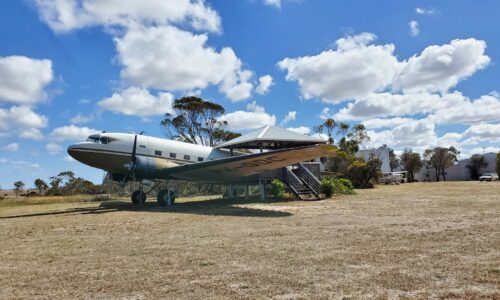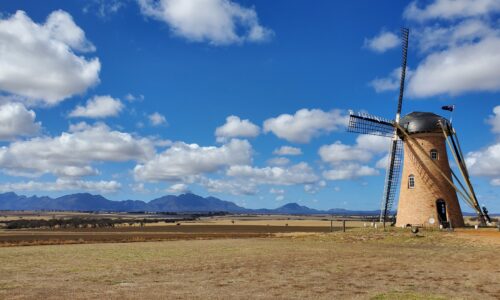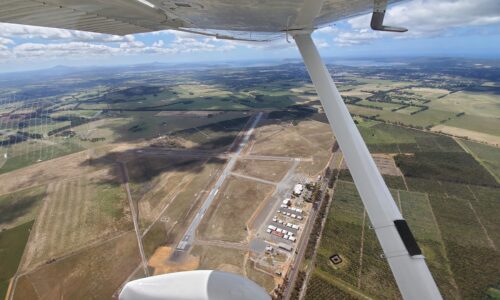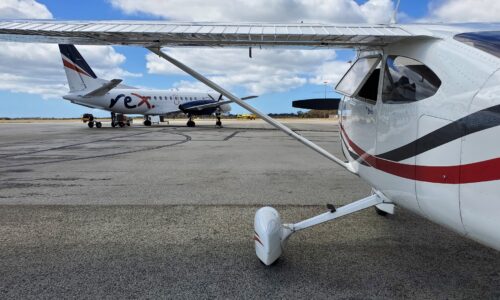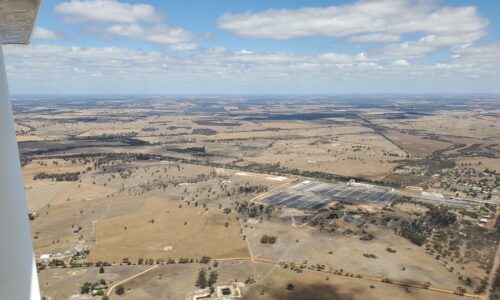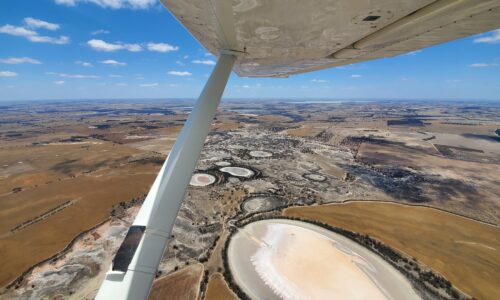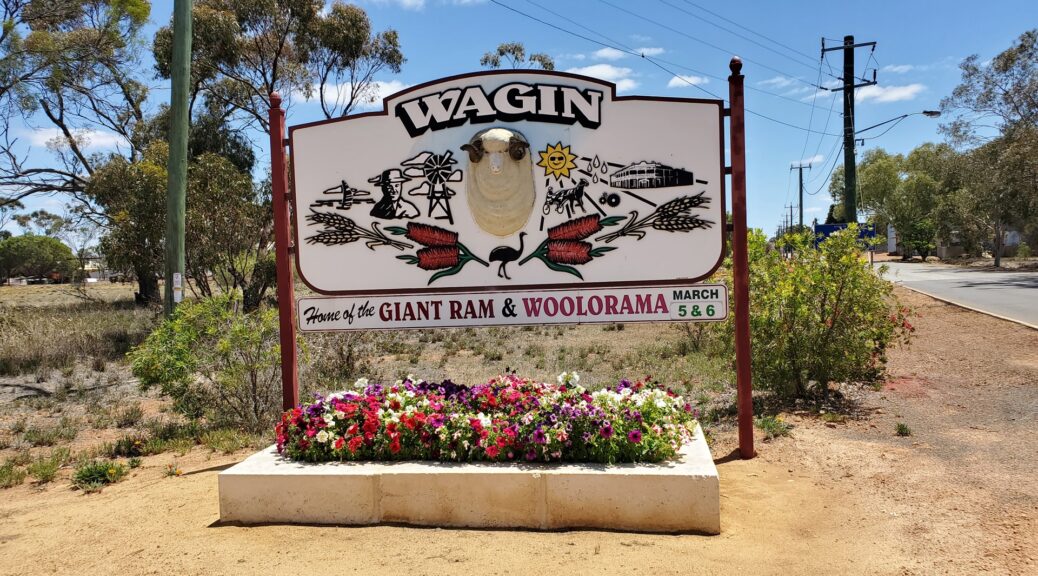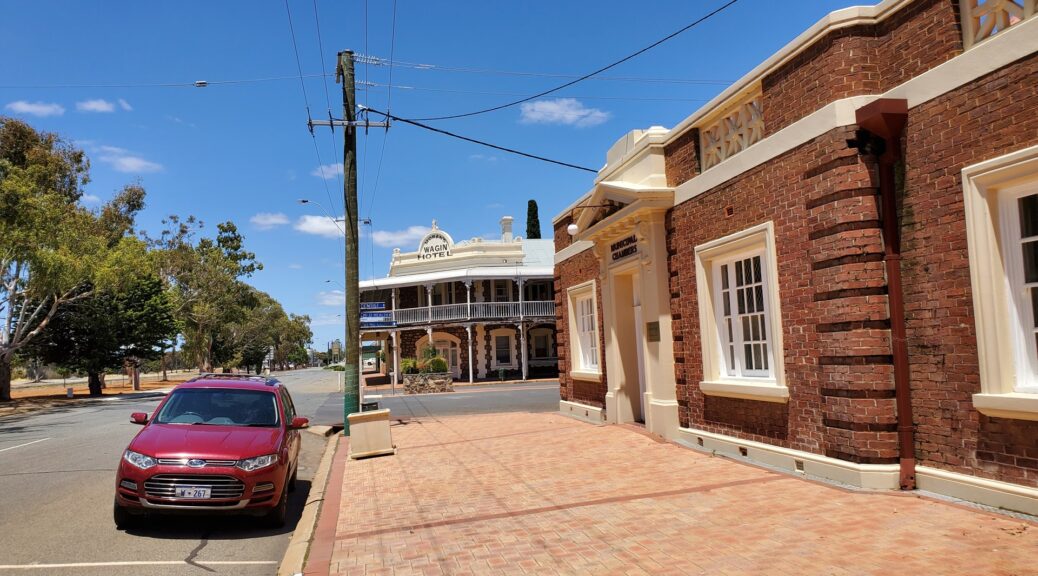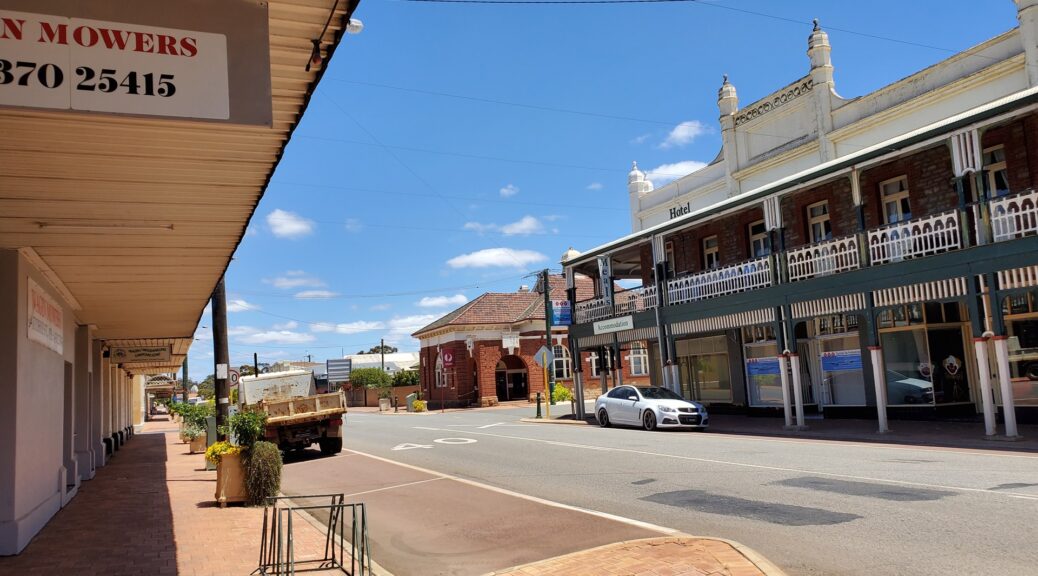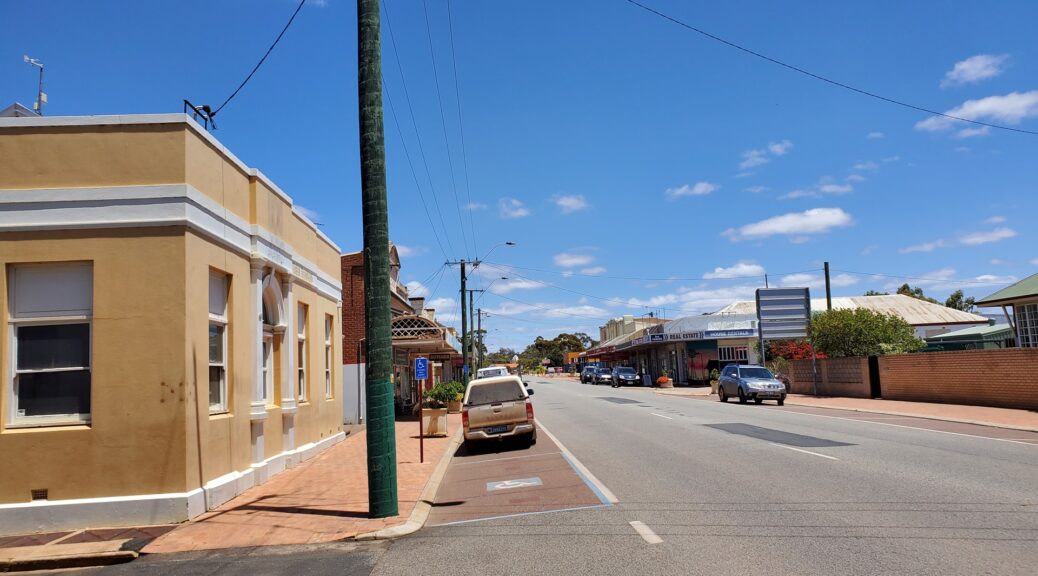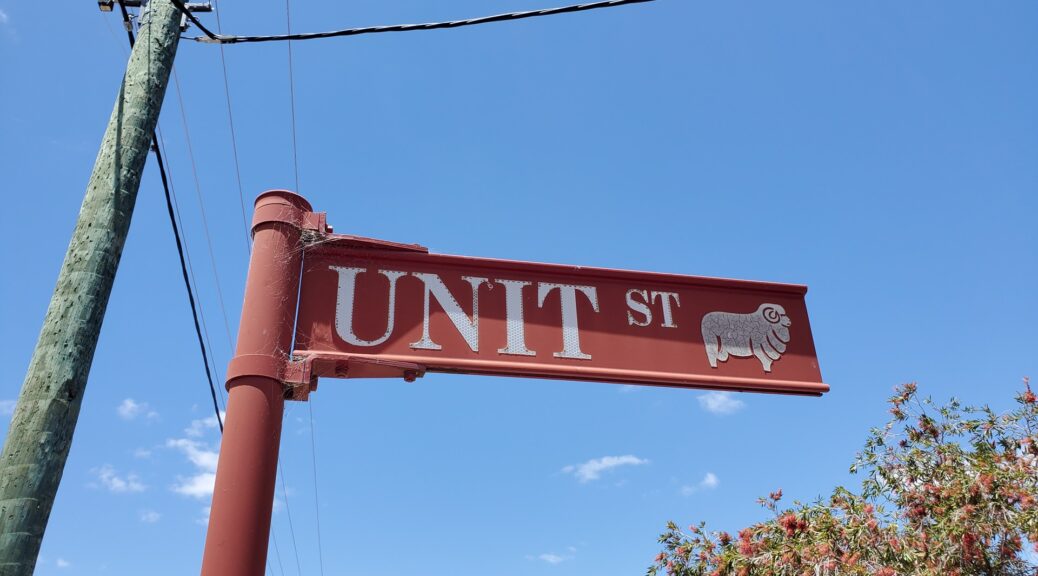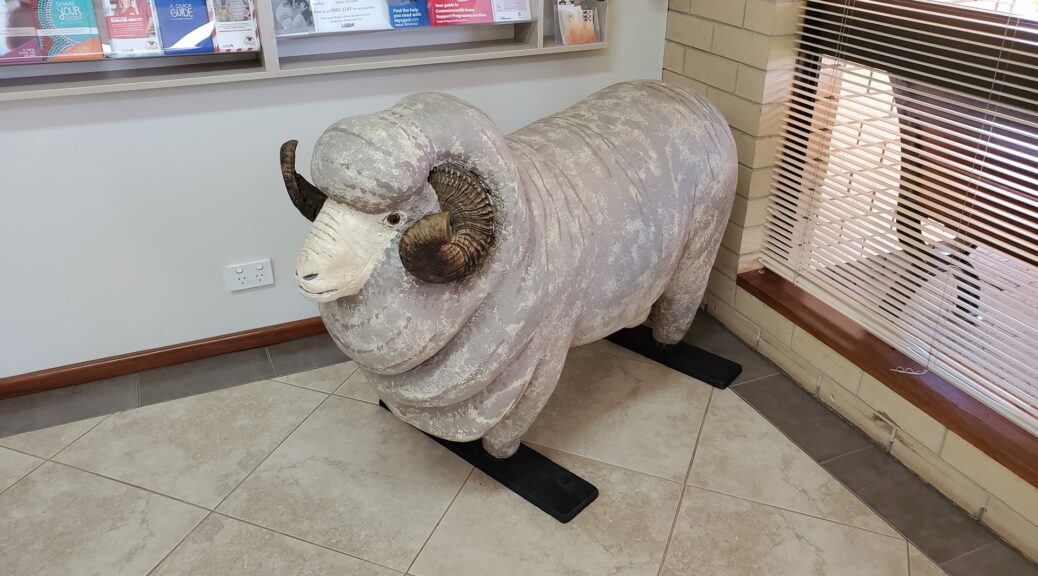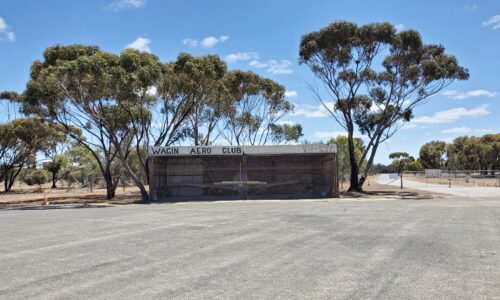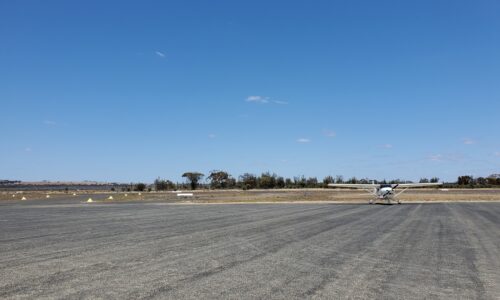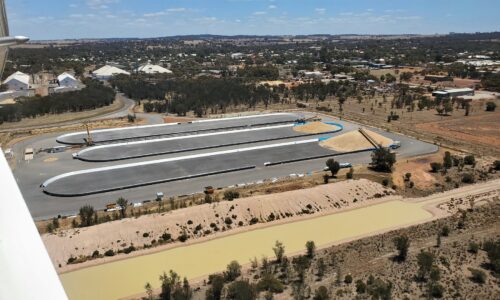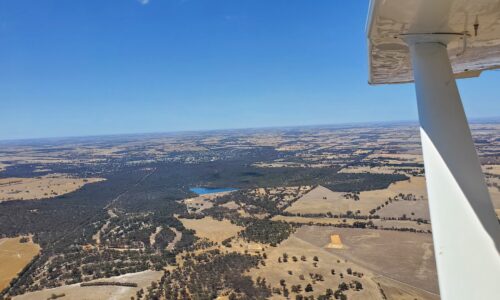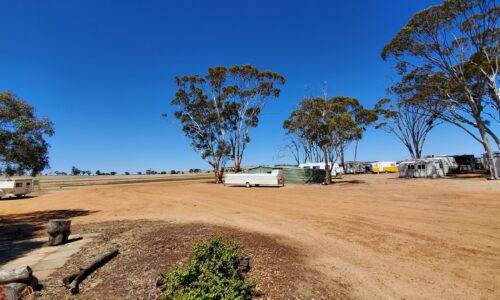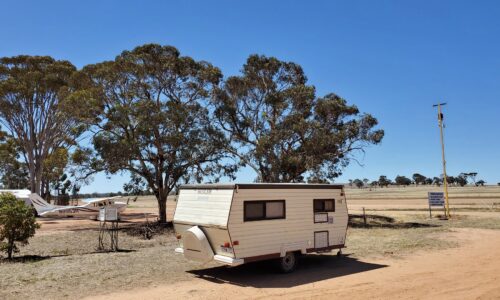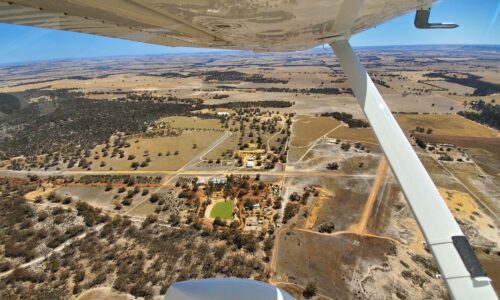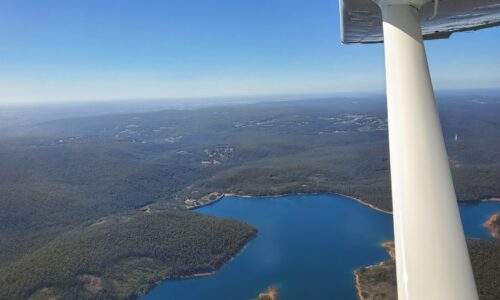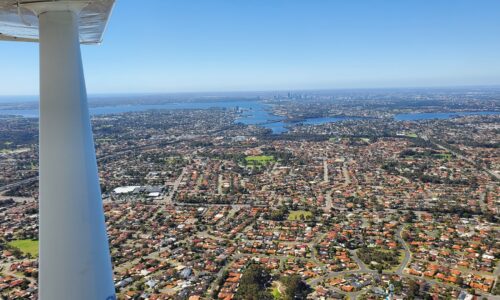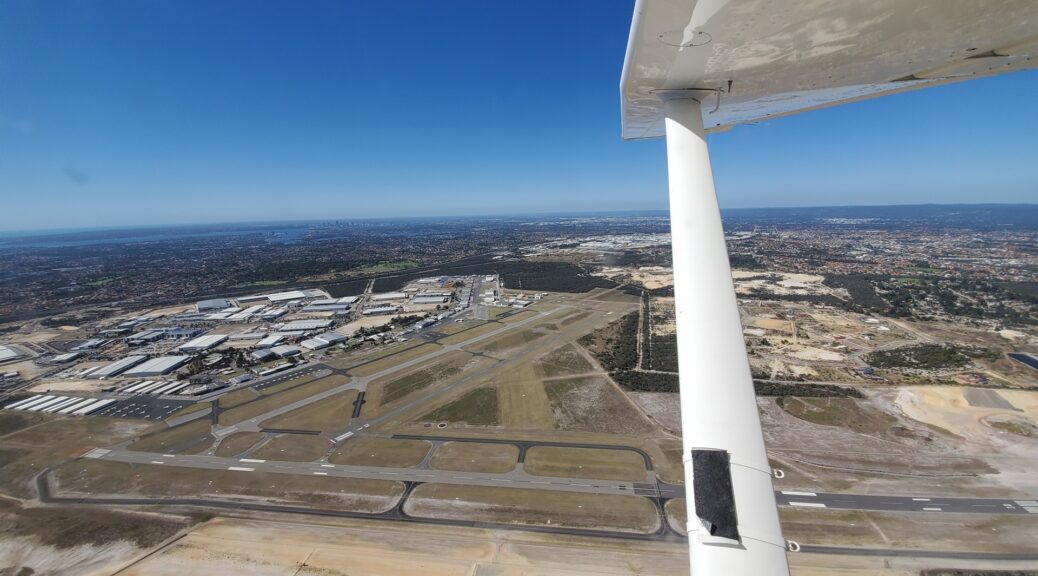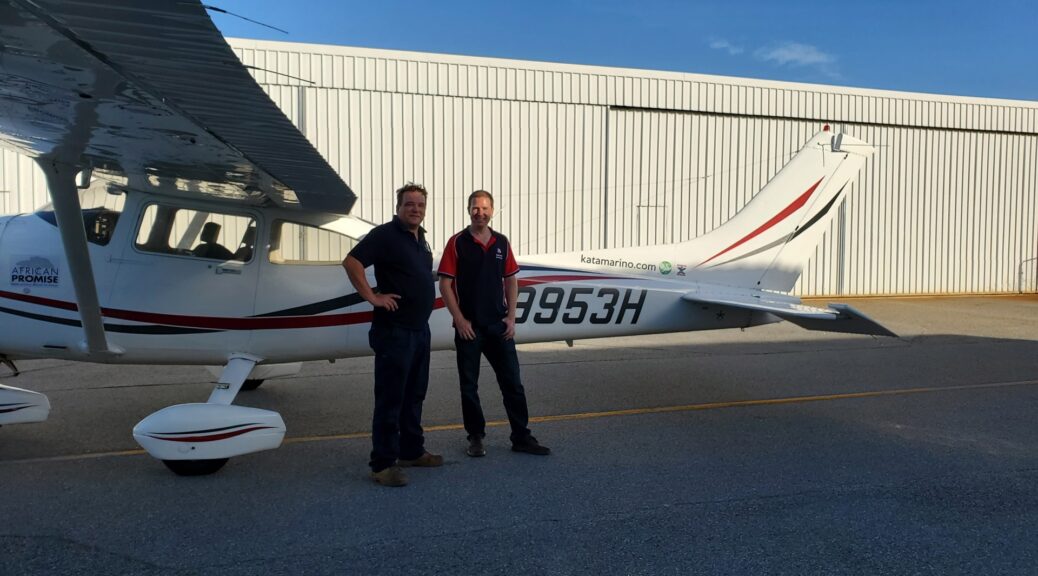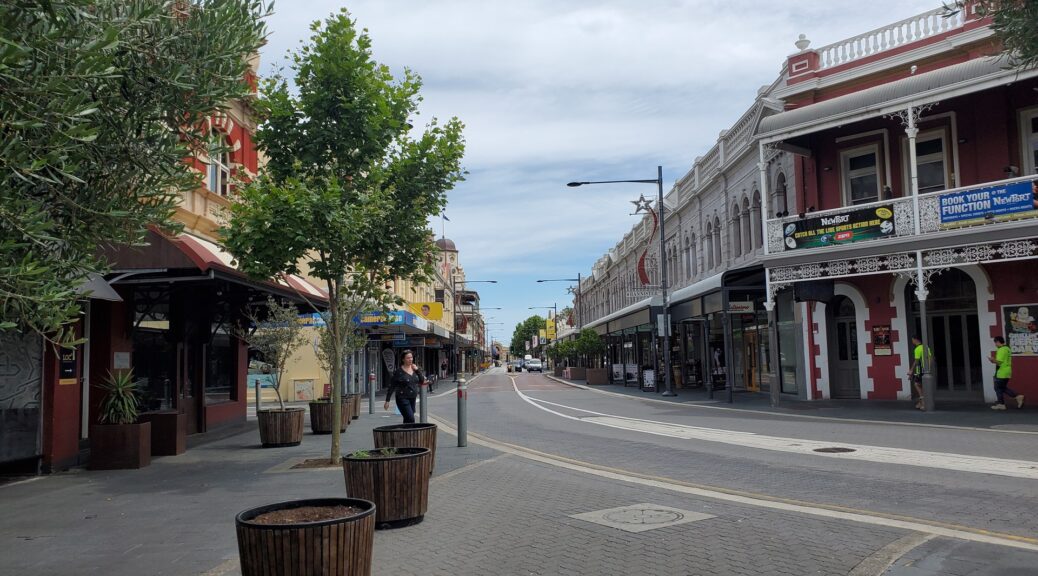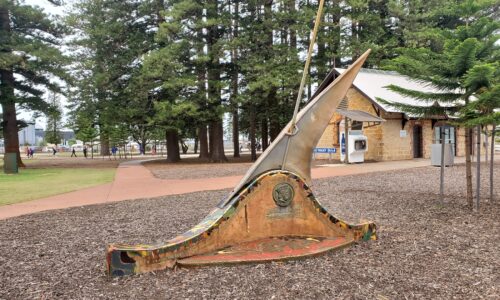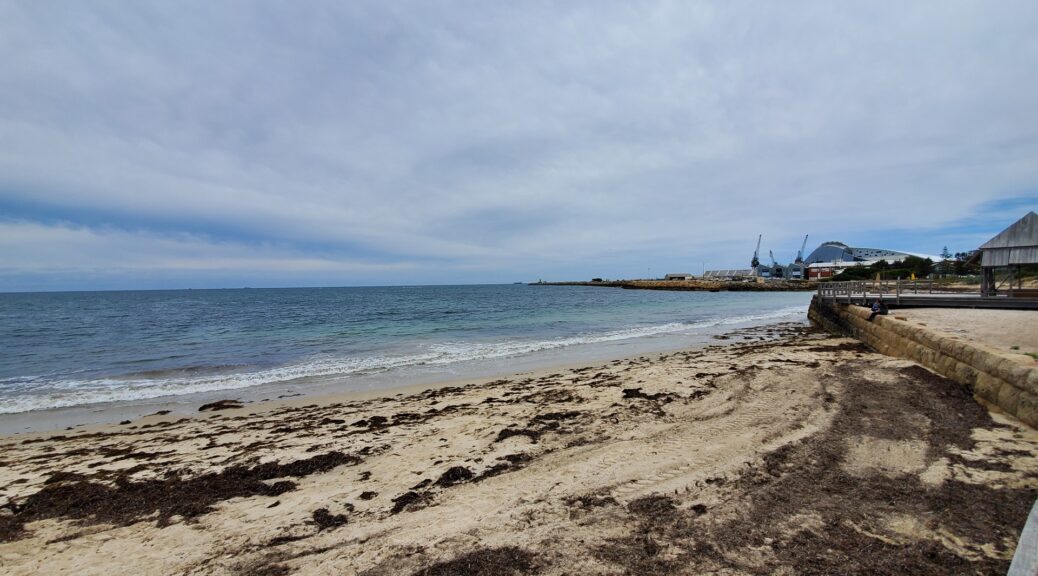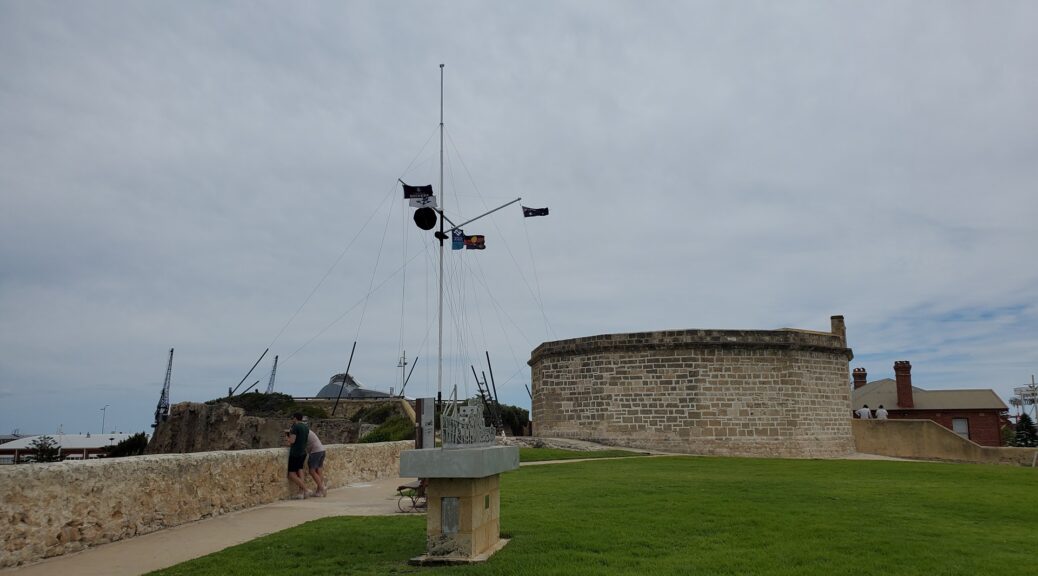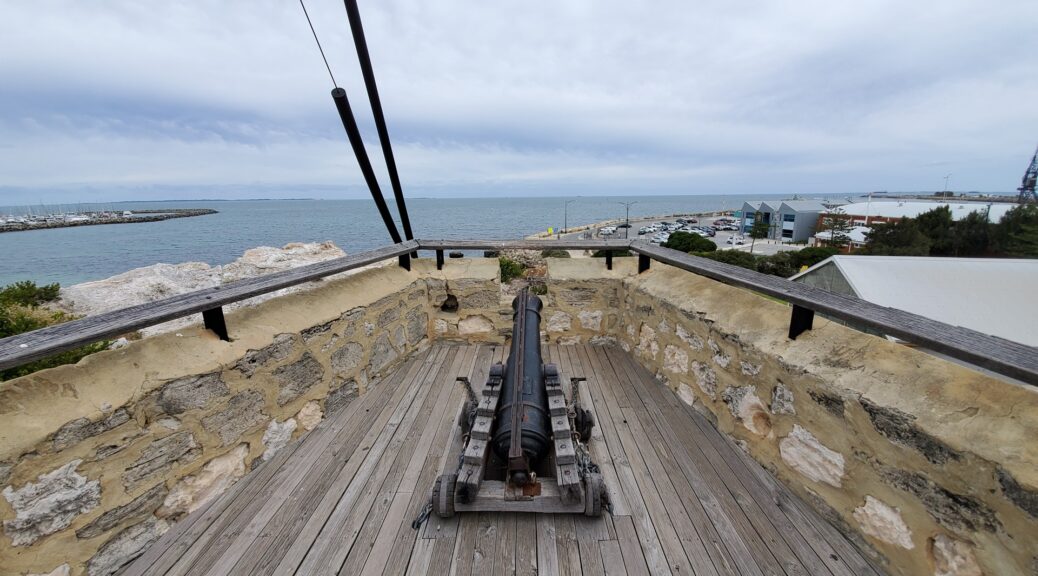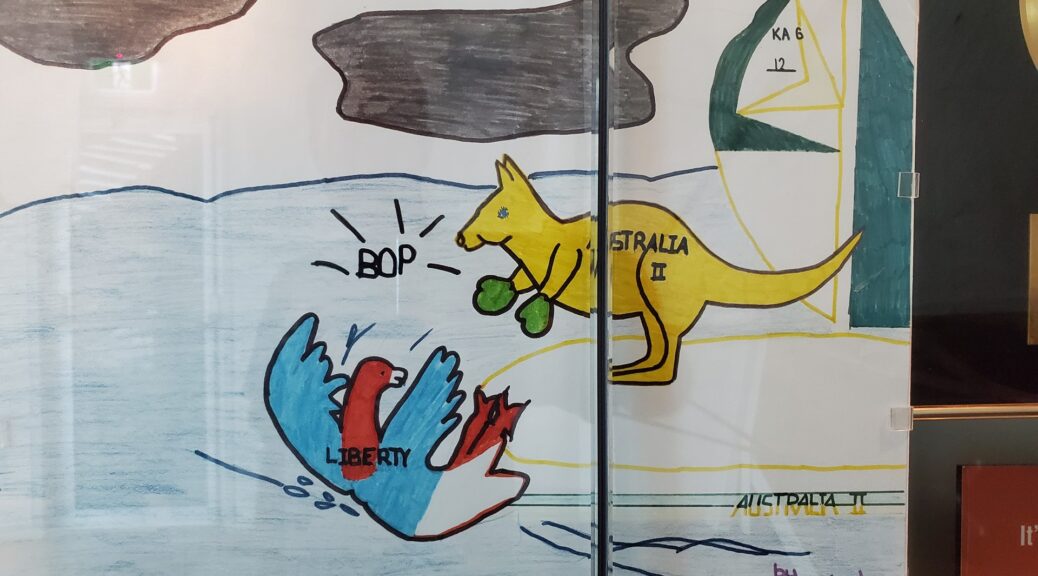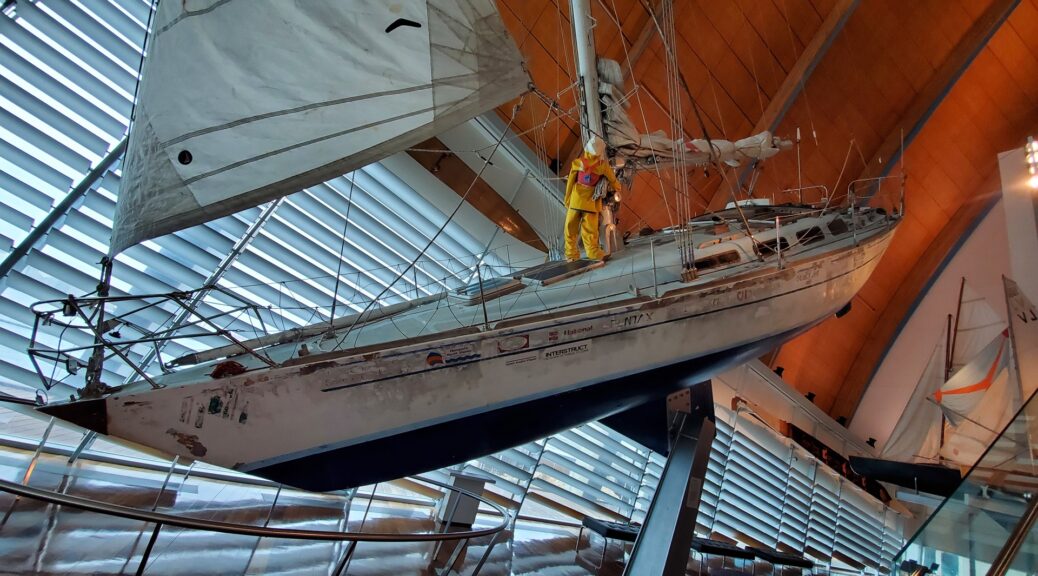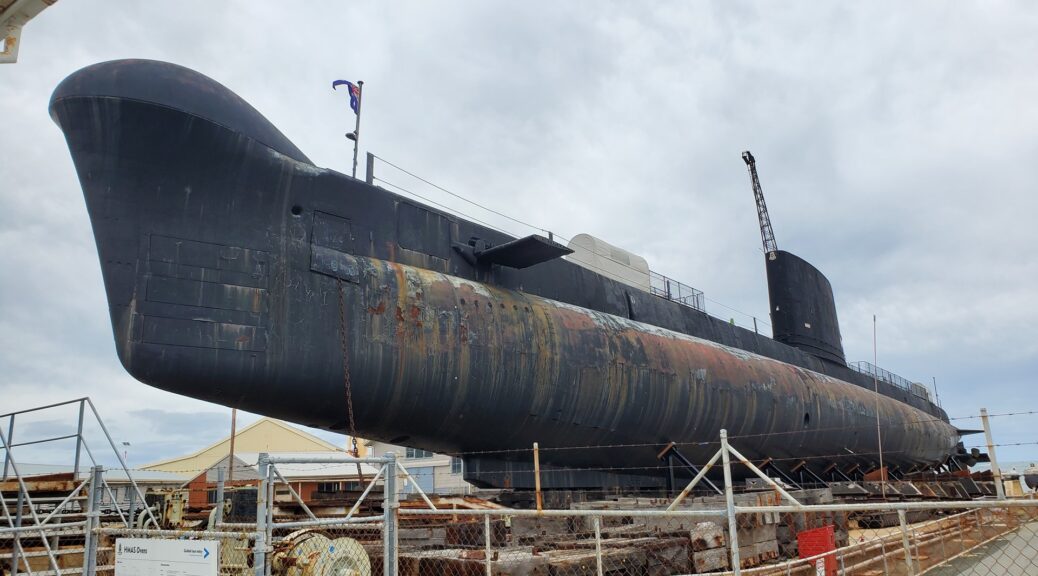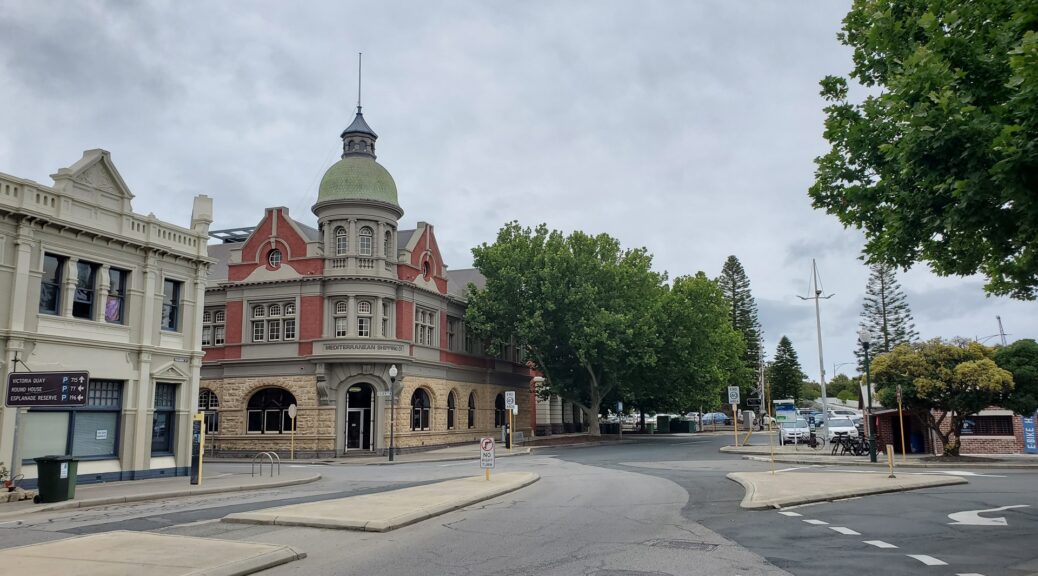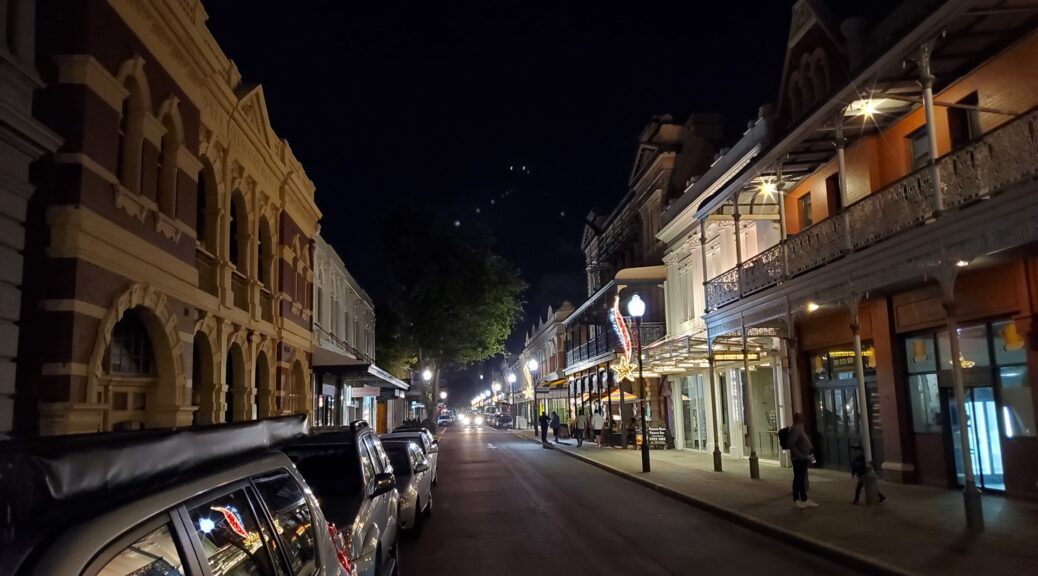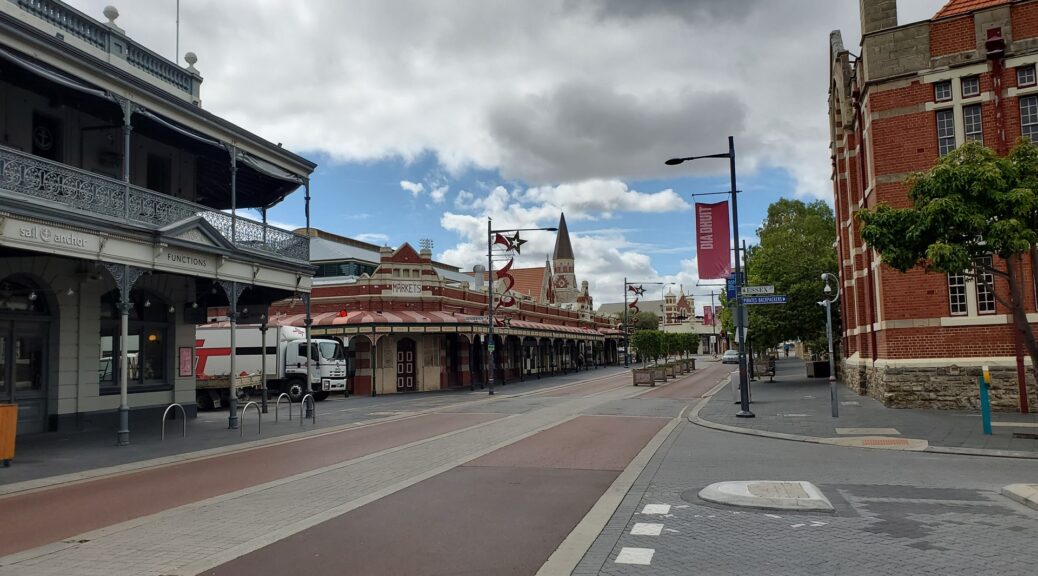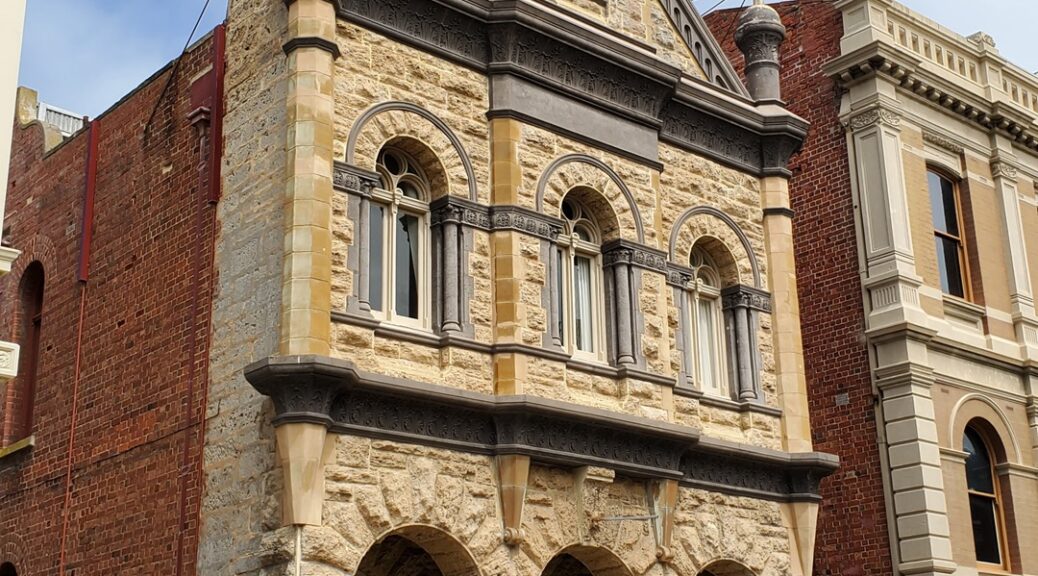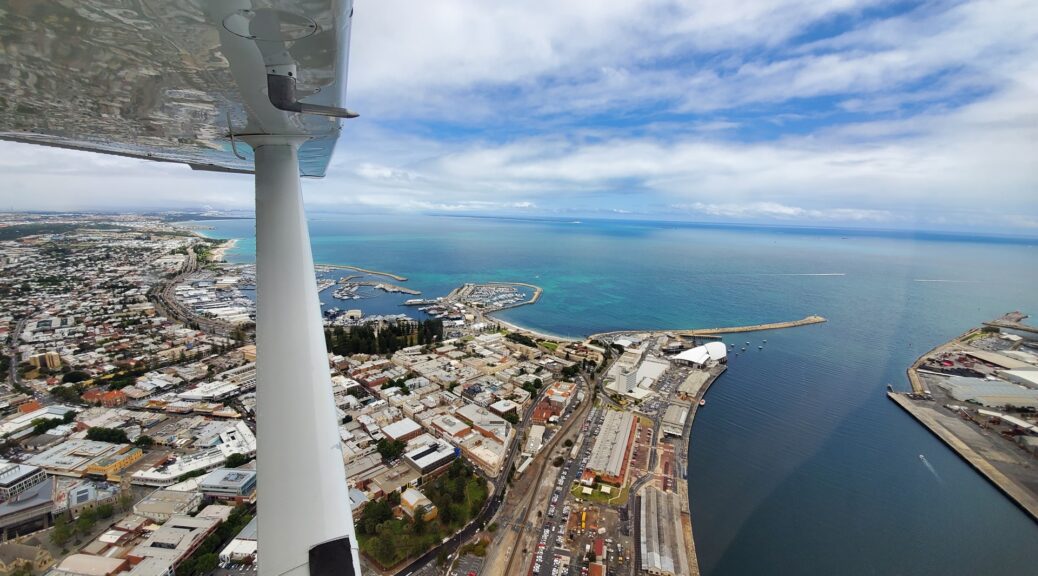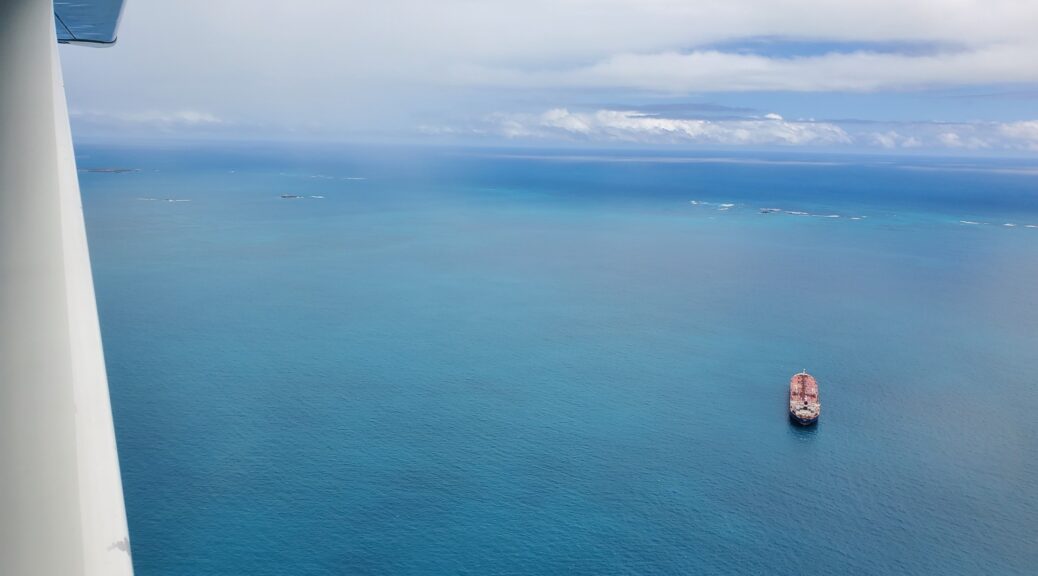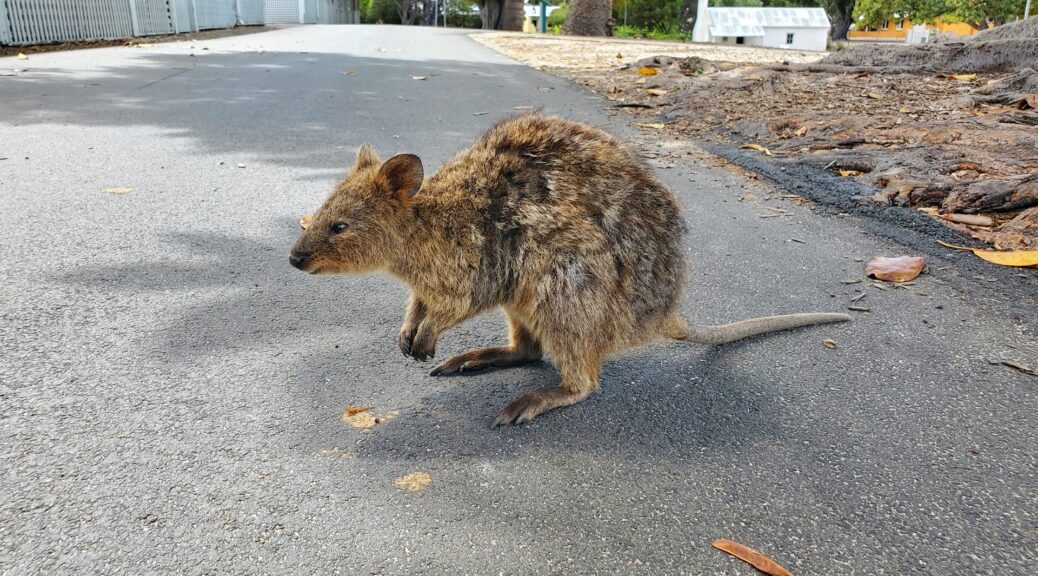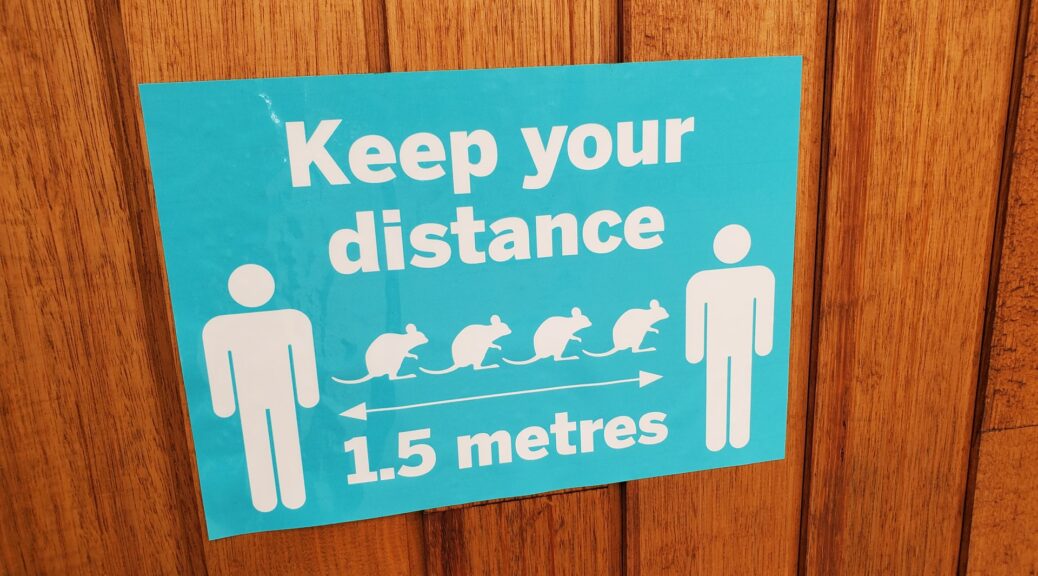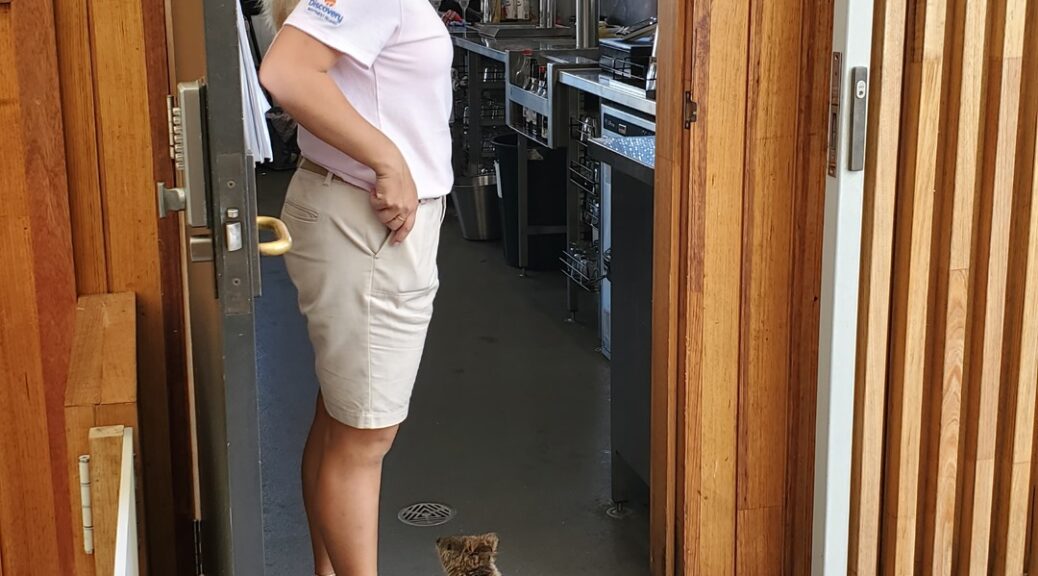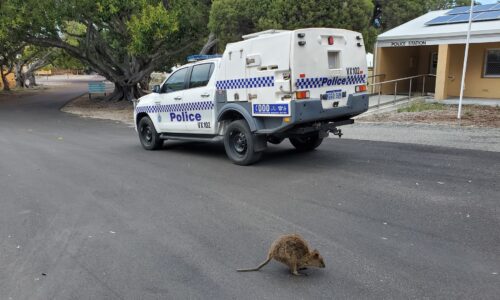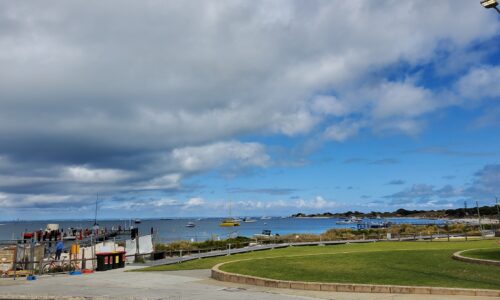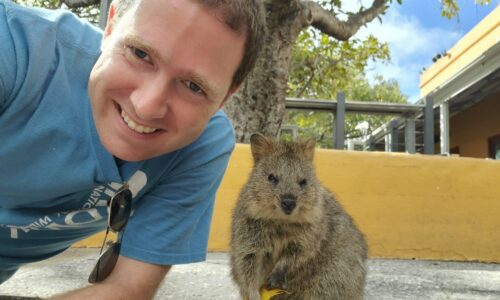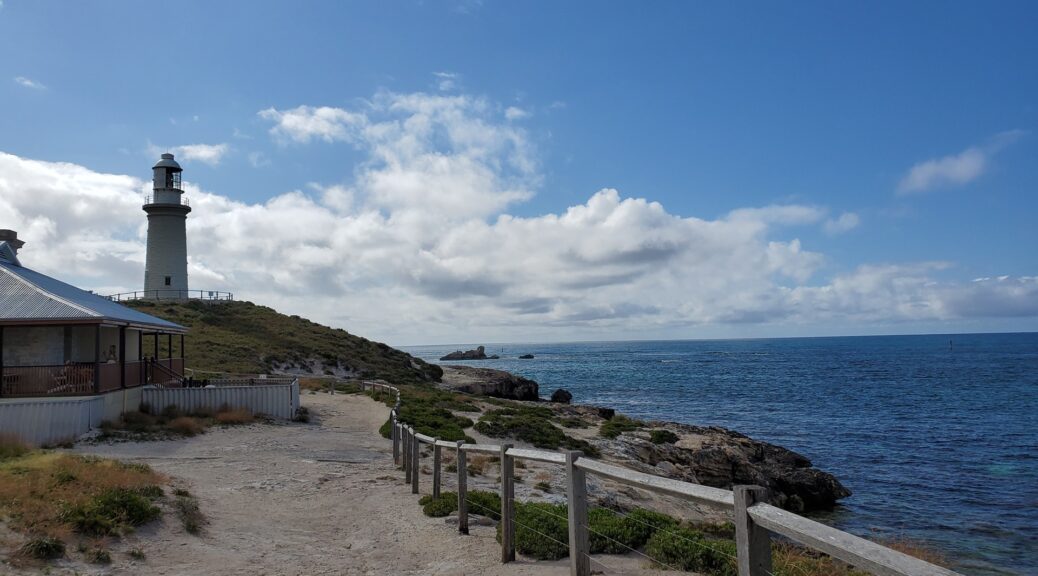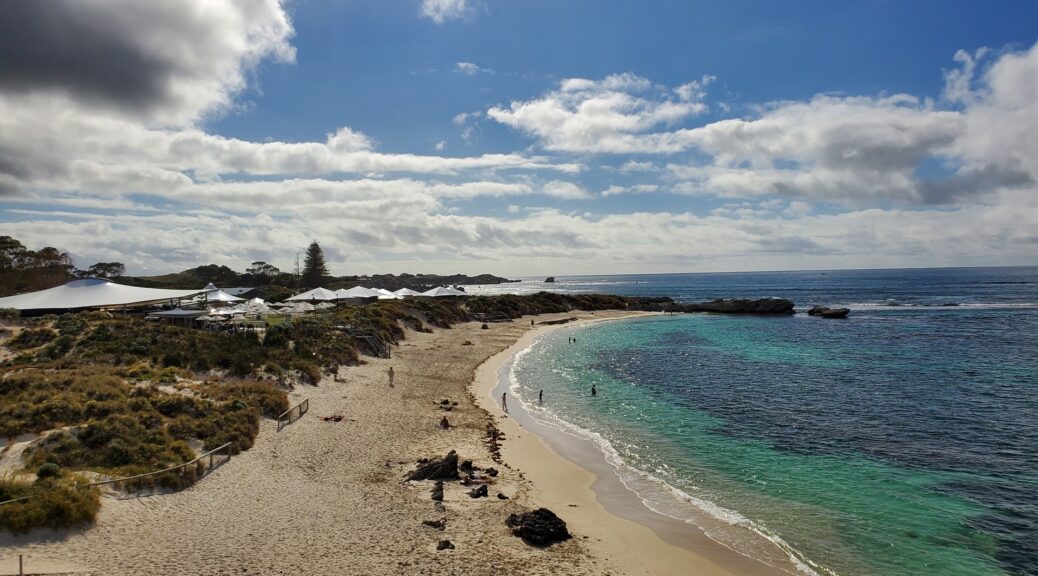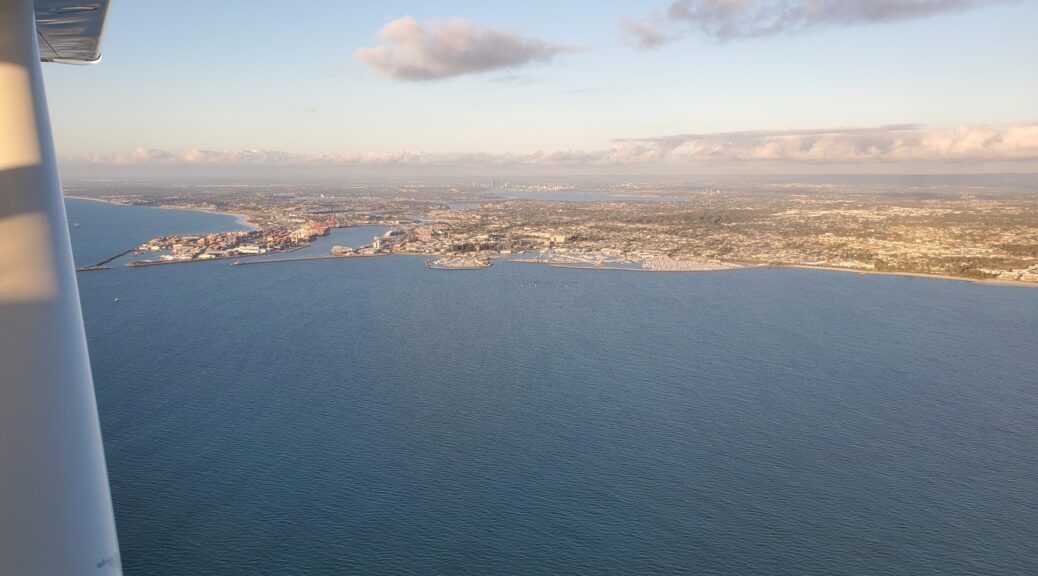Round the World – Australia 2, Part 6
The morning sun over The Lily was beautiful, and I spent a while taking pictures of the Stirling Range, the windmill, and the DC3. Pleun and Hennie had kindly provided me with a light packed breakfast. I managed, for the very first time ever, to smack my head hard on the lowered flaps of Planey while performing a preflight, resulting in blood pouring all over the ground and slightly disturbing Pleun and his friend. As with most head injuries it looked much worse than it was and everything was soon back to normal.
At some point the previous day an inspection panel had departed from the front section on Planey’s starboard wing, probably as a result of my removing them to inspect the leaking fuel and perhaps not properly tightening one on replacement. I had moved one to replace it, taking one from the rear of the wing underneath where the flaps retract. Pleun’s friend donated a new one to me, and we drilled the appropriate holes before fitting it. Good as new.
My destination for the day was Jandakot airport, the main general aviation airport for Perth. As always, there’d be a few stops along the way. Availability of fuel to the north of The Lily was questionable so I first made a 30 minute flight south to the airport at Albany; I had phoned the fueler there and they confirmed they could help me out. Off I went!
I arrived in Albany moments after a small commercial turboprop. They took fueling priority, so I hung out for a few minutes. A second fueler turned up after a while and filled me up, so I was soon on my way back to the north. Fighting a moderate headwind, I made brief stops at the airports of Cranbrook and Katanning before arriving at the town of Wagin. Wagin is home to the “Big Ram”!
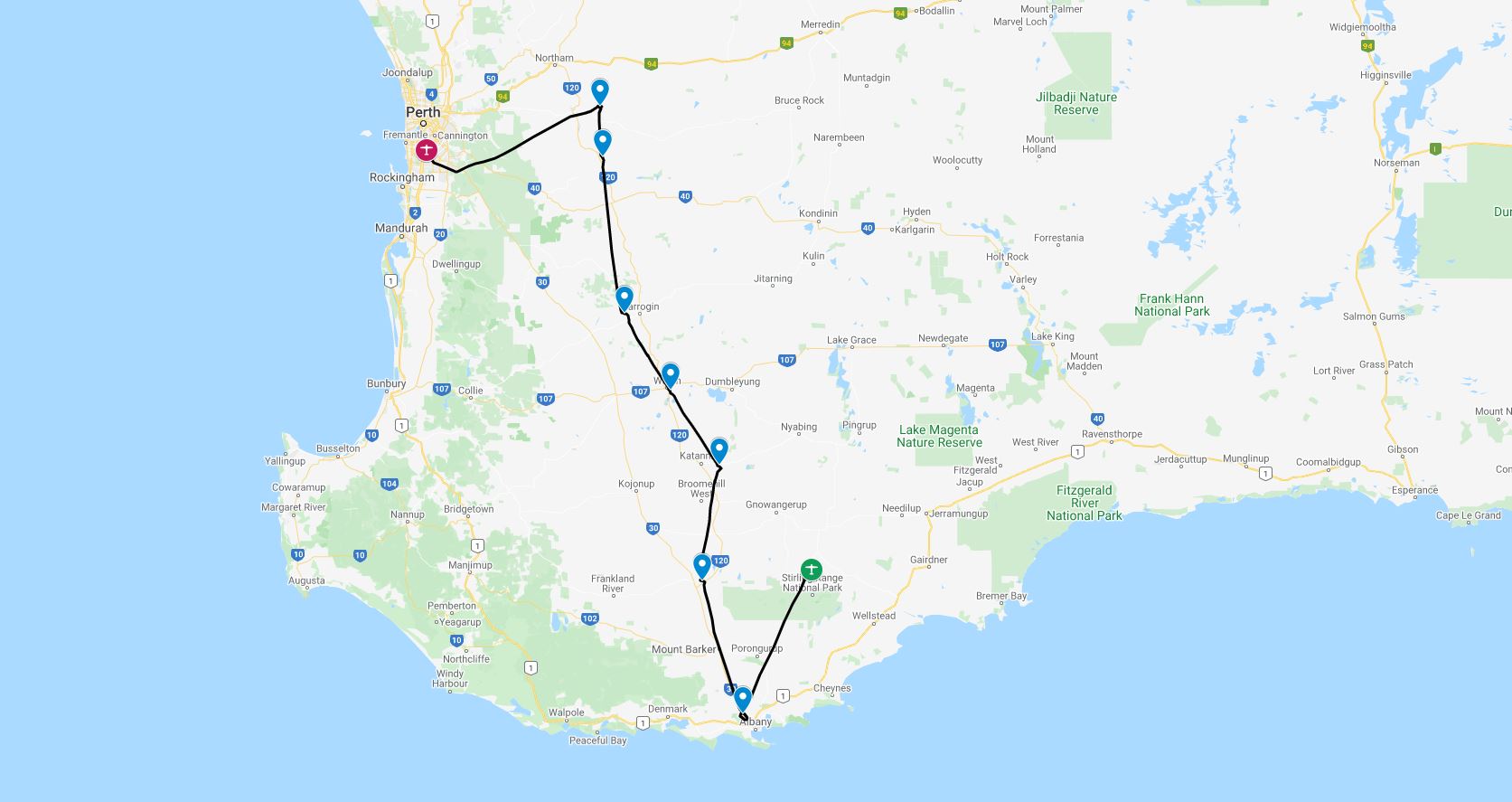
Wagin airport was deserted. I parked up at the edge of the apron, donned my wide-brimmed hat, and grabbed a bottle of water. It was approaching noon, and it was going to be a 30+ minute walk to the aptly named “Giant Ram Park”. Wagin’s name is derived from the nearby dry lake of Lake Wagin, which itself is derived from the local Noongar language meaning “site of the foot tracks from when the emu sat down”. The town itself came into existence after the construction of the Great Southern Railway which was completed in 1889, with the first post office being completed in 1993. Today it has a population of just under 2,000 and is primarily a service town for local agriculture, as with many other towns in this region.
Despite my hopes, nobody had stopped to offer me a lift, and I entered the town on foot. I stopped for a toastie and a cold drink at a local bakery before continuing down the main street towards Giant Ram Park. The ram itself is visible from quite a distance, peeking out between the trees.
The ram was erected in 1985, as a tourist attraction. It stands 9 metres (30 ft) tall, 13 metres (43 ft) long and 6 metres (20 ft) wide and weighs 4 tonnes. This is a pretty big ram, yet Wikipedia states that it is only the second largest sculpture of this kind in the southern hemisphere. Goulburn’s Giant Merino is a little larger. Despite not quite claiming the “biggest ram” crown, Wagin’s ram is still a very impressive piece. The “Atlas Obscura” does note one redeeming feature:
However, what the Wagin ram lacks in height it makes up in genitalia size. While the Goulburn ram was not built with any visible reproductive organs, the proud Wagin ram sports a rather impressive faux-woolen pair between its oversized hind legs. The big balls are a popular photo opportunity and while sculptural scrotums are not unheard of (see the Wall Street Bull), they are almost never featured on giant-size installation. The ram even stands on a pavilion so that visitors can stroll beneath its bulk and inspect its undercarriage.
https://www.atlasobscura.com/places/giant-ram
I stopped in at the adjacent municipal office to enquire about alternative means of returning to the airport. Ozzie hospitality kicked in again and the town manager gave me a lift back to Planey. It was time to continue north for the final few stops of the day.
My first stop was Narrogin, home of a large gliding club. The only person around was a pilot doing some refurbishment work on his Diamond DA20 aircraft. I rested for a while from the heat and turbulence before continuing on to Beverley, a large dirt strip and home of another even larger gliding club; the largest in Western Australia with nearly 100 active pilots. Beverley was constructed back in 1943 as a satellite base for the Royal Navy’s Fleet Air Arm. With the exception of a Mooney carrying out some practice landings, nobody else was in sight.
My final stop before Perth was the airstrip at White Gum. This air park is located near York, and is home to a microlight school as well as many other interesting tenants. They offer hangars for rent that include a small accommodation area, ideal for weekends away from the city. A salvaged Boeing 737-200 sits at the airstrip for visitors to come and explore; apparently there are plans to offer accommodation soon in that, too! I landed on the cross-wind runway at the top of the “T” shape the runways make up, and taxied along the out-of-use runway to parking. This was on a rather steep slope, a bit nerve-wracking!
I crossed the runway and introduced myself at the microlight school, White Gum Aviation. A couple of instructors and students were around and were happy to tell me a little about the airstrip. They were also kind enough to pull up the Perth aviation chart on their computer, and talk me through the arrival to Jandakot airport; there are a number of standard VFR arrival and departure routes, and they briefed me on which one to expect when coming in from the east. As I started Planey up and taxied out, I felt fully prepared for the final leg!
The flight over the forested hills east of Perth was smooth, and on calling up air traffic control I was directed exactly as the White Gum Aviation team had predicted. The arrival directed me a little south, over the Wungong Regional Park, before turning north towards Jandakot. I had great views of Perth as I approached and joined a downwind to land. After touching down, I taxied to the southern end of the apron and into the rows of private hangars. A helpful man called Ben had offered me assistance in changing the oil. While I waited for his arrival I was able to walk out of the Royal Aero Club and across the road to Western Airmotive, where I could buy fresh oil and a filter ready for the maintenance work.
Ben arrived as I got back with the supplies and we took the cowl off, drained the old oil and replaced it with new, and fitted a new oil filter. This would see me ready for the remaining flights through Australia back to the east coast! Ben had to leave once we’d finished the work, but yet another helpful man, this time by the name of Trevor, had been in touch; he collected me from the airport and we drove into Fremantle for a Thai meal with his partner. It was great to have finally reached the west coast!
Fremantle, known affectionately to the locals as Freo, serves as the port for Perth and is a lovely little suburb of the city in itself. Based on recommendations from friends, I had decided to spend two nights here rather than in central Perth. It’s a very walkable city, so I set out on foot in the morning to find some breakfast and then explore the town a little. Named after a British naval officer who claimed the coast for Britain, Fremantle was the first area settled by the Swan River colonists in 1829. The port was a major submarine base in World War II with upwards of 160 submarines operating from it at times, and its maritime pedigree was deepened in 1987 when it hosted Australia’s defence of the America’s Cup. Today, Fremantle is recognised for its well-preserved Victorian and Edwardian streetscapes and convict-era heritage, and is known as a bohemian enclave with a thriving arts and culinary scene; it also handles almost the entirety of container freight traffic for Western Australia.
In line with its reputation, Fremantle had no shortage of little cafés and finding a good breakfast was straightforward. This done, I made my way down to the waterfront to explore a little of the maritime heritage. A very strange sight for my northern-hemisphere eyes was a park full of parrots, pecking at the ground; I was more used to seeing pigeons, so this felt very exotic!
At the far end of the park I came upon the Western Australia Shipwrecks museum, described (by their own website) as the “foremost maritime archaeology museum in the southern hemisphere”. Entry was free, involving only a temperature scan in an attempt to ward off any COVID. The museum houses all kinds of artifacts from primarily Dutch shipwrecks in the region, with the centerpiece being a large section of timbers from the Batavia, which wrecked in 1629. Wikipedia describes the wreck, and horrific aftermath:
Batavia was a ship of the Dutch East India Company. Built in Amsterdam in 1628 as the company’s new flagship, she sailed that year on her maiden voyage for Batavia, capital of the Dutch East Indies.
On 4 June 1629, the Batavia was wrecked on the Houtman Abrolhos, a chain of small islands off the coast of Western Australia. As the ship broke apart, 40 of the 341 passengers drowned in their attempts to reach land. The ship’s commander, Francisco Pelsaert, sailed to Batavia to get help, leaving merchant Jeronimus Cornelisz in charge. Cornelisz sent about 20 men to nearby islands under the pretense of having them search for fresh water, abandoning them there to die. He then orchestrated a mutiny that, over course of several weeks, resulted in the murder of approximately 125 of the remaining survivors, including women, children and infants; a small number of women were kept as sexual slaves, among them the famed beauty Lucretia Jans, who was reserved by Cornelisz for himself.
Meanwhile, the men sent away had unexpectedly found water and, after learning of the atrocities, waged battles with the mutineers under soldier Wiebbe Hayes’ leadership. In October, at the height of their last and deadliest battle, they were interrupted by the return of Pelsaert aboard the Sardam. He subsequently tried and convicted Cornelisz and six of his men, who became the first Europeans to be legally executed in Australia. Two other mutineers, convicted of comparatively minor crimes, were marooned on mainland Australia, thus becoming the first Europeans to permanently inhabit the Australian continent. Of the original 332 people on board Batavia, only 122 made it to the port of Batavia.
https://en.wikipedia.org/wiki/Batavia_(1628_ship)
I emerged into the sunlight, hoping to find a more cheerful destination after learning all about the Batavia. I wandered along the shore at Bathers Bay and came upon The Roundhouse. This was built in 1830, and was the first permanent building of the Swan River Colony. It was used as a prison, which shows the priorities of the early settlers. It is now open to the public with various exhibits about the early days of the settlement. After looking around I continued into the port area and arrived at the Western Australia Maritime Museum.
The WA Maritime Museum is located on Victoria Quay and contains galleries with themes such as the Indian Ocean, the Swan River, fishing, maritime trade and naval defence. One of the museum’s highlights is the yacht Australia II, which won the America’s Cup for Australia in 1983. A particular highlight was the piece of artwork featuring Australia’s boxing kangaroo defeating the American eagle. Also on display was the 47ft yacht Parry Endeavour, sailed by Australian yachtsman Jon Sanders for his solo, non-stop triple circumnavigation of the world. This took him almost 420 days; significantly less time than it had so far taken me to complete a single circumnavigation in an airplane! As of January 2021 Jon was still actively sailing and had just completed his 11th circumnavigation of the globe.
Next door to the maritime museum sits the Oberon class submarine HMAS Ovens. Sadly tours were on hold due to the COVID risks, but a guide was available and took me for a free outside tour of the vessel.
The evening was spent planning some upcoming flights, as well as enjoying a meal sitting outside in downtown Fremantle. It’s hard to beat Fremantle weather!
After another Fremantle breakfast, I took a ride back to Jandakot and returned to Planey. My plan was to make a short flight over to Rottnest Island, a few miles off the coast from Fremantle and home to the wonderful quokka. Before departure I was met by a local plane spotter who had contacted me and arranged to come and take some photographs of Planey. I may not be famous, but at least Planey is!
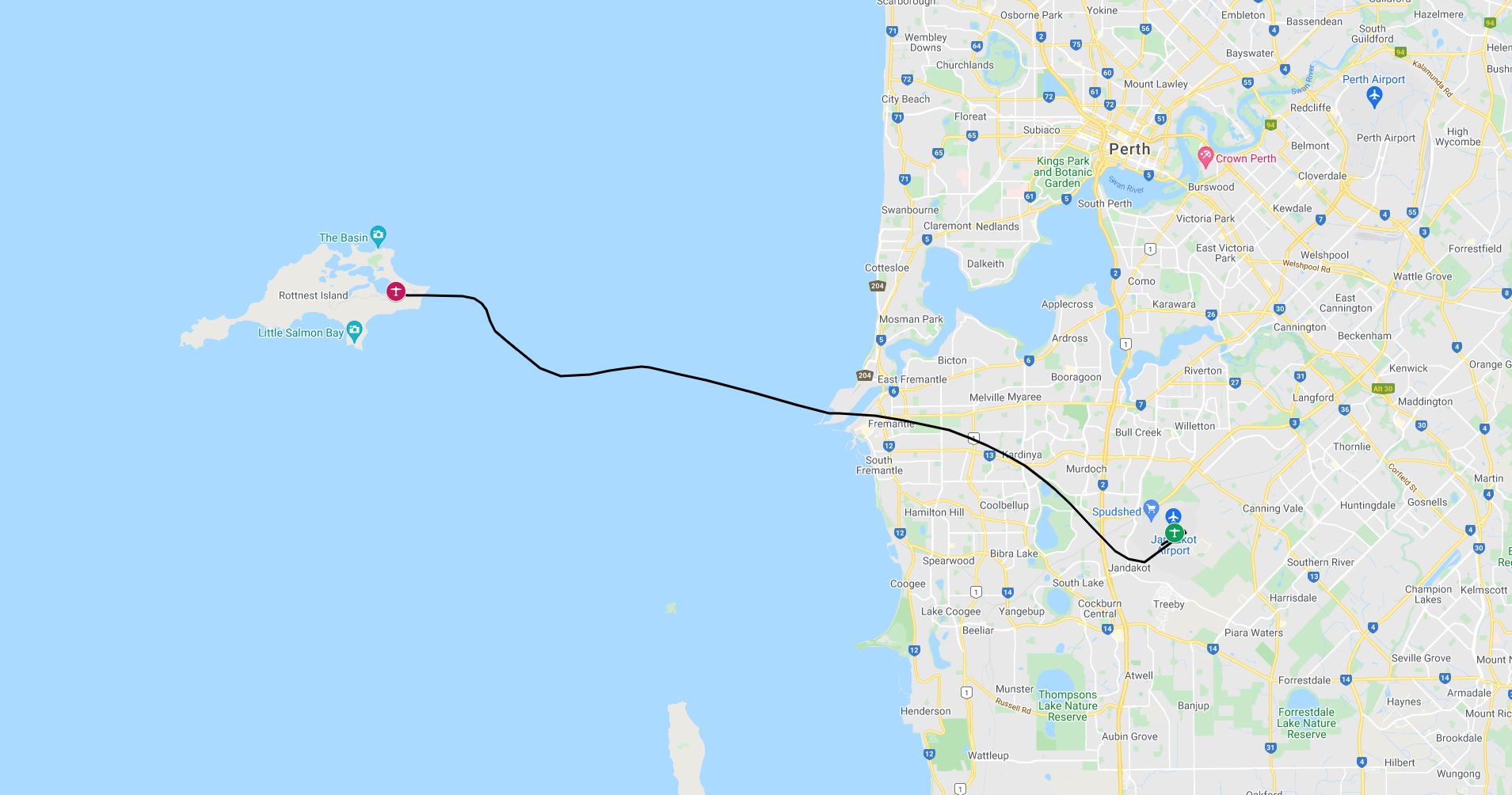
There was a little low cloud hanging over the water between Perth and Rottnest Island, but fortuitously it was just to the north of my route. As I cleared the coast Rottnest was already in sight ahead, under clear blue skies. A couple of other aircraft were inbound, so we spoke to each other over the radio and sorted out a landing order. I followed a six seat Piper in and parked up at one side of the apron, taking the time to fit the cover in case any of the nearby rain-showers came in this direction. A worker in the little terminal building directed me on the best way to get to my accommodation, a combination of bus ride and walk. As soon as I set foot off the bus, the adorable quokkas could be seen in abundance!
The quokka is also known as short-tailed scrub wallaby. Like the kangaroo and other wallabies it is a marsupial, carrying its young in a pouch. What makes it unique, particularly on Rottnest Island, is that they have almost no fear of humans. They roam happily around human populated areas and will allow one to approach them as close as one wishes, making for great “selfies”. A few unlucky tourists are bitten each year, but all survive!
I walked past many quokkas on the way to my accommodation. As I was checking in, one particularly persistent quokka was attempting to make its way into the kitchen of the hotel’s café. I set down my belongings in my room and set off to have a look around the area, and hopefully get some of the essential quokka photos for which the island is known.
Rottnest did not disappoint, and I enjoyed a relaxed lunch with Pina Colada overlooking the bay. That done, I headed back to the central area where most of the little marsupials seemed to hang out, before enjoying some quality quokka time. They were just as fearless as I had heard, lounging around with no regard for the people milling about, and looking on placidly as tourists came close for photographs. Signs on most businesses politely requested that people prevent quokkas from bouncing in, and those businesses with open fronts simply had to accept the fact that they’d have regular quokka visitors!
After lunch I took a stroll back along the coast to enjoy the views, ending up back at my hotel for a rest and some flight planning for the upcoming days. The vast majority of the houses in the area seemed to be small holiday cabins for people from Perth and beyond to come out and spend a few days or weeks. I passed the Bathurst Lighthouse, built in 1900 in response to a number of shipwrecks in the area such as the 1,200 ton City of York which sank in 1899 just a few miles from its destination of Fremantle after sailing from San Francisco. The 1,500 ton Carlisle Castle also foundered in the same storm close to Rottnest with the loss of all hands.
It was at this point that things went off the rails. Shortly after I got back to my room I heard a knock at the door. On opening it I discovered a policeman wearing gloves and a mask; rarely a good thing. He proffered a mask to me, and started questioning me in detail on my whereabouts since arriving in Western Australia. I asked him if he’d mind telling me what was going on, and he told me that since my departure from Adelaide some cases of COVID had been detected there; Western Australia was now rounding up everyone who’d arrived from the entire state of South Australia and directing them to isolation. Apparently they’d been running around trying to track me down.
My first reaction was to ask why they didn’t just call or email me, as they had these details from the approved entry request I had submitted online before entering the state. He told me that he wasn’t sure, but he thought it likely that nobody could work out how to dial an international phone number! No reasoning was given for the inability to email. I was politely but firmly instructed that after he gave me a lift back to the airport I should fly directly back to Jandakot, and then go straight to a hotel of my choosing where I should isolate for another ten days. This would be quite a blow to my planned itinerary!
There were no police to greet me when I arrived back at Jandakot; I secured the aircraft, and took an Uber to my chosen hotel to begin a fairly boring week and a half.
Click here to read the next part of the story.

